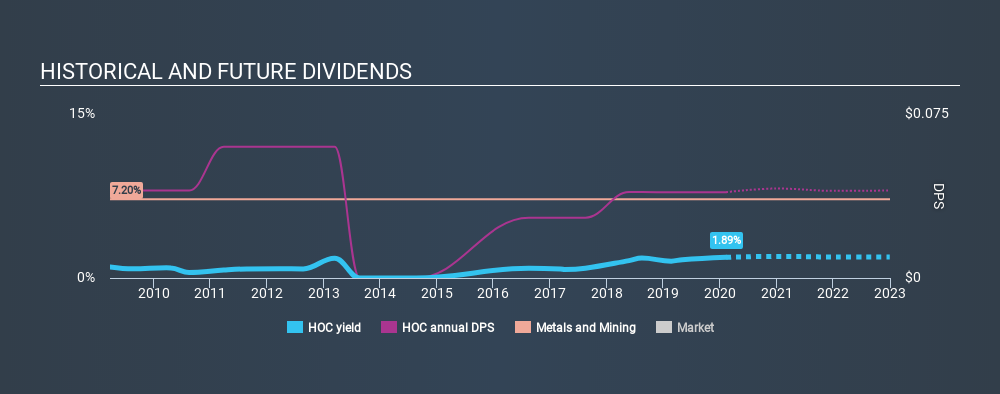- United Kingdom
- /
- Metals and Mining
- /
- LSE:HOC
Key Things To Consider Before Buying Hochschild Mining plc (LON:HOC) For Its Dividend

Could Hochschild Mining plc (LON:HOC) be an attractive dividend share to own for the long haul? Investors are often drawn to strong companies with the idea of reinvesting the dividends. On the other hand, investors have been known to buy a stock because of its yield, and then lose money if the company's dividend doesn't live up to expectations.
A 1.9% yield is nothing to get excited about, but investors probably think the long payment history suggests Hochschild Mining has some staying power. There are a few simple ways to reduce the risks of buying Hochschild Mining for its dividend, and we'll go through these below.
Explore this interactive chart for our latest analysis on Hochschild Mining!

Payout ratios
Dividends are usually paid out of company earnings. If a company is paying more than it earns, then the dividend might become unsustainable - hardly an ideal situation. So we need to form a view on if a company's dividend is sustainable, relative to its net profit after tax. Looking at the data, we can see that 150% of Hochschild Mining's profits were paid out as dividends in the last 12 months. Unless there are extenuating circumstances, from the perspective of an investor who hopes to own the company for many years, a payout ratio of above 100% is definitely a concern.
We also measure dividends paid against a company's levered free cash flow, to see if enough cash was generated to cover the dividend. Hochschild Mining paid out 55% of its cash flow as dividends last year, which is within a reasonable range for the average corporation. It's good to see that while Hochschild Mining's dividends were not covered by profits, at least they are affordable from a cash perspective. Still, if the company repeatedly paid a dividend greater than its profits, we'd be concerned. Extraordinarily few companies are capable of persistently paying a dividend that is greater than their profits.
Is Hochschild Mining's Balance Sheet Risky?
As Hochschild Mining's dividend was not well covered by earnings, we need to check its balance sheet for signs of financial distress. A quick check of its financial situation can be done with two ratios: net debt divided by EBITDA (earnings before interest, tax, depreciation and amortisation), and net interest cover. Net debt to EBITDA is a measure of a company's total debt. Net interest cover measures the ability to meet interest payments. Essentially we check that a) the company does not have too much debt, and b) that it can afford to pay the interest. With net debt of 0.28 times its EBITDA, Hochschild Mining has an acceptable level of debt.
Net interest cover can be calculated by dividing earnings before interest and tax (EBIT) by the company's net interest expense. Hochschild Mining has interest cover of more than 12 times its interest expense, which we think is quite strong.
Consider getting our latest analysis on Hochschild Mining's financial position here.
Dividend Volatility
One of the major risks of relying on dividend income, is the potential for a company to struggle financially and cut its dividend. Not only is your income cut, but the value of your investment declines as well - nasty. For the purpose of this article, we only scrutinise the last decade of Hochschild Mining's dividend payments. The dividend has been cut on at least one occasion historically. During the past ten-year period, the first annual payment was US$0.04 in 2010, compared to US$0.039 last year. Dividend payments have shrunk at a rate of less than 1% per annum over this time frame.
When a company's per-share dividend falls we question if this reflects poorly on either external business conditions, or the company's capital allocation decisions. Either way, we find it hard to get excited about a company with a declining dividend.
Dividend Growth Potential
With a relatively unstable dividend, it's even more important to evaluate if earnings per share (EPS) are growing - it's not worth taking the risk on a dividend getting cut, unless you might be rewarded with larger dividends in future. Strong earnings per share (EPS) growth might encourage our interest in the company despite fluctuating dividends, which is why it's great to see Hochschild Mining has grown its earnings per share at 54% per annum over the past five years. The company has been growing its EPS at a very rapid rate, while paying out virtually all of its income as dividends. While EPS could grow fast enough to make the dividend sustainable, in this type of situation, we'd want to pay extra attention to any fragilities in the company's balance sheet.
Conclusion
When we look at a dividend stock, we need to form a judgement on whether the dividend will grow, if the company is able to maintain it in a wide range of economic circumstances, and if the dividend payout is sustainable. We're not keen on the fact that Hochschild Mining paid out such a high percentage of its income, although its cashflow is in better shape. We were also glad to see it growing earnings, but it was concerning to see the dividend has been cut at least once in the past. While we're not hugely bearish on it, overall we think there are potentially better dividend stocks than Hochschild Mining out there.
Earnings growth generally bodes well for the future value of company dividend payments. See if the 9 Hochschild Mining analysts we track are forecasting continued growth with our free report on analyst estimates for the company.
We have also put together a list of global stocks with a market capitalisation above $1bn and yielding more 3%.
If you spot an error that warrants correction, please contact the editor at editorial-team@simplywallst.com. This article by Simply Wall St is general in nature. It does not constitute a recommendation to buy or sell any stock, and does not take account of your objectives, or your financial situation. Simply Wall St has no position in the stocks mentioned.
We aim to bring you long-term focused research analysis driven by fundamental data. Note that our analysis may not factor in the latest price-sensitive company announcements or qualitative material. Thank you for reading.
About LSE:HOC
Hochschild Mining
A precious metals company, engages in the exploration, mining, processing, and sale of gold and silver deposits in Peru, Argentina, the United States, Canada, Brazil, and Chile.
Reasonable growth potential and fair value.


